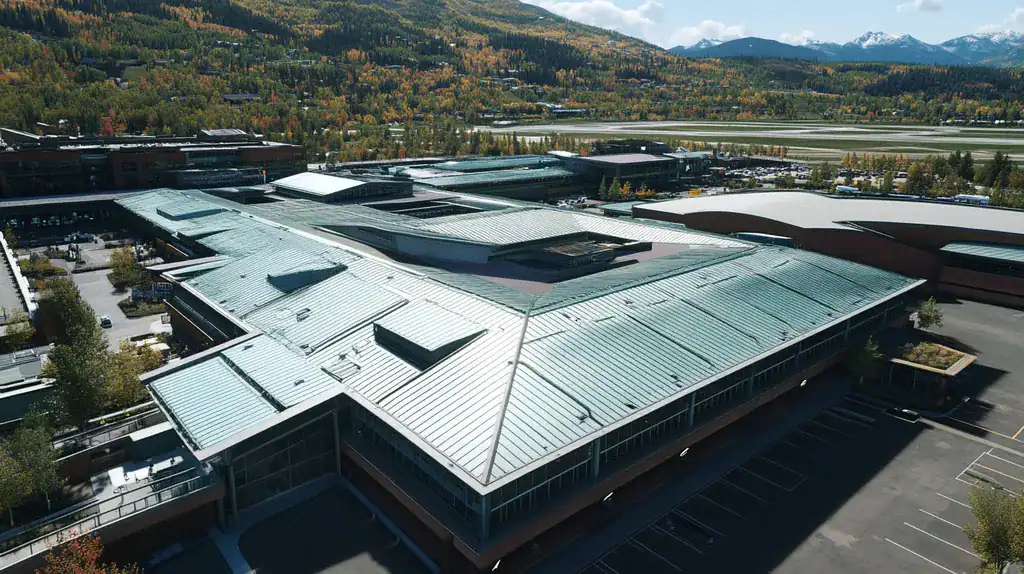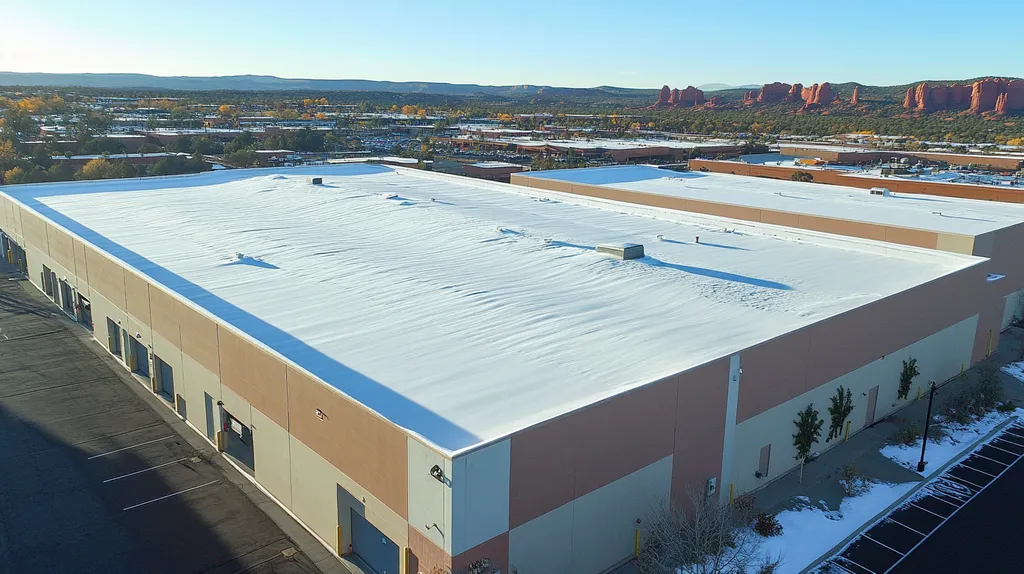Every year, commercial roofing projects generate over 13 billion pounds of waste material, yet widespread misconceptions about disposal methods cost facility managers millions in fines and lost recycling opportunities.
The stakes are particularly high as regulatory bodies increase scrutiny of commercial waste disposal practices, with single violations often exceeding $50,000 in penalties.
This comprehensive guide separates fact from fiction regarding roofing material disposal, examining common myths, practical challenges, and evidence-based solutions that protect both facilities and their bottom lines.
SECTION 1: COMMON MISCONCEPTIONS
When managing commercial roofing projects, disposal of old materials presents critical challenges that can impact both budget and compliance. Poor disposal decisions can result in hefty fines, environmental violations, and unexpected costs that derail project timelines. Understanding the realities of material disposal is essential for facility managers to protect their organizations and maintain regulatory compliance.
Mythical Recycling Practices
The belief that all roofing materials can be recycled creates dangerous assumptions in project planning. While metal components and some membrane materials offer recycling potential, many composite materials require specialized handling or must be sent to landfills.
Local recycling facilities often reject commercial roofing materials due to contamination concerns or processing limitations. This reality forces facility managers to find alternative disposal methods, often at higher costs than initially budgeted.
The complexity of material separation also impacts recycling feasibility. Layers of different materials bonded together during installation often cannot be separated cost-effectively, making recycling impractical.
Some managers assume recycling always offers cost savings, but processing fees and transportation costs can make recycling more expensive than traditional disposal in many cases.
Misunderstood Waste Regulations
Compliance with waste disposal regulations requires more than simply hiring a disposal service. Each jurisdiction has specific requirements for handling and documenting commercial roofing waste, with violations carrying significant penalties.
Many facility managers overlook the requirement for material testing before disposal. Older roofing systems may contain hazardous materials that require specialized handling and documentation.
The responsibility for proper disposal ultimately rests with the property owner, not the contractor. Even when using licensed disposal services, facility managers must verify compliance with local regulations.
Disposal regulations can vary significantly between jurisdictions, making standardized approaches risky. What’s acceptable in one location may violate regulations in another.
Misconceptions About Material Disposal
The most dangerous assumption is that dumpster rental alone ensures proper disposal. While dumpsters offer convenience, proper sorting and documentation remain essential for regulatory compliance. (source: Dumpsters.com)
Many facility managers underestimate the volume of waste generated during roof replacement. A typical commercial project can produce significantly more waste than anticipated, leading to additional dumpster rentals and disposal fees.
The belief that disposal costs are always included in contractor bids creates budget surprises. Without specific inclusion in contract documents, disposal costs often become expensive change orders.
Documentation requirements for material disposal frequently exceed expectations. Maintaining proper disposal records is crucial for both immediate compliance and future property transactions.
SECTION 2: PRACTICAL IMPLICATIONS
The disposal of roofing materials presents facility managers with complex challenges that directly impact project costs, timelines, and environmental compliance. With commercial roofing waste contributing nearly 8 million tons to landfills annually, proper disposal has become a critical concern. Understanding and addressing the practical implications of material disposal helps facility managers avoid costly mistakes while maintaining regulatory compliance and operational efficiency.
Regulatory Compliance Challenges
Navigating the complex web of disposal regulations requires careful attention to local, state, and federal requirements. Each jurisdiction maintains specific guidelines for handling different types of roofing materials, with violations resulting in substantial fines and potential project shutdowns.
Documentation requirements often catch facility managers off guard. Many jurisdictions require detailed waste manifests, material testing reports, and disposal verification before allowing project completion.
Chain of custody tracking presents another significant challenge. Facility managers must maintain accurate records from removal through final disposal, particularly for materials classified as potentially hazardous.
The responsibility for compliance extends beyond the initial disposal. Many facilities face additional scrutiny during property transactions or refinancing when disposal records come under review.
Environmental Impact Considerations
The environmental consequences of roofing material disposal extend far beyond simple landfill space consumption. Chemical leaching from improperly disposed materials can contaminate groundwater and soil, creating long-term environmental liabilities.
Low-slope roof membranes require specific handling procedures during removal to maximize recycling potential. Proper separation of materials not only reduces environmental impact but also creates opportunities for material reuse in paving and other applications. (source: Asphalt Roofing Manufacturers Association)
Many facilities overlook the carbon footprint associated with material transportation. Strategic planning of disposal routes and recycling locations can significantly reduce environmental impact while controlling costs.
Forward-thinking facilities are increasingly adopting zero-waste initiatives that prioritize material recycling and reuse over traditional disposal methods.
Operational Inefficiencies
Poor coordination between removal crews and disposal services frequently creates bottlenecks that delay projects and increase labor costs. Effective scheduling requires careful alignment of workspace clearance, material staging, and pickup timing.
Material sorting inefficiencies often result in missed recycling opportunities and higher disposal fees. Training crews in proper separation techniques helps maximize material recovery while minimizing contamination.
Storage constraints during large-scale projects can create safety hazards and workflow disruptions. Developing detailed staging plans helps prevent material buildup and maintain safe working conditions.
Many facilities underestimate the impact of weather on disposal operations. Rain events can saturate materials, increasing weight-based disposal fees and complicating handling procedures.
SECTION 3: COST OF MISINFORMATION
When facility managers operate with outdated or incorrect information about roofing material disposal, the financial consequences can be devastating. Recent industry data shows individual disposal violations frequently exceed $100,000 in fines and remediation costs. Beyond immediate penalties, improper disposal creates long-term liabilities that can impact property values and future transactions.
Financial Burden of Mismanagement
Poor disposal planning creates cascading costs that extend far beyond initial budget projections. What begins as an attempt to save money through cheaper disposal options often results in exponential expenses when violations are discovered.
Emergency remediation costs for improperly disposed materials typically run 5-10 times higher than proper initial disposal. These unexpected expenses frequently force facilities to defer other critical maintenance, creating a dangerous cycle of deferred upkeep.
The impact extends to insurance premiums and property valuations. Documented disposal violations can trigger coverage exclusions and reduce property values, creating long-term financial repercussions that affect overall facility operations.
Risks of Non-Compliance Fines
Failure to comply with disposal regulations exposes facilities to substantial penalties at federal, state and local levels. This is particularly critical when dealing with hazardous materials like asbestos, which require specialized handling and documentation.
Enforcement actions can include both monetary penalties and mandatory operational shutdowns. The North Carolina Division of Public Health emphasizes that non-compliance with asbestos regulations during roofing removal triggers severe NESHAP violations requiring accredited workers for remediation. (source: North Carolina Division of Public Health)
Multiple violations compound quickly, with each day of non-compliance often treated as a separate violation. This multiplier effect can turn a single disposal mistake into a six-figure penalty.
Beyond direct fines, facilities face increased scrutiny and mandatory monitoring periods after violations. These oversight requirements add administrative burden and compliance costs that strain operational budgets.
Missed Opportunities for Savings
Many facilities overlook substantial cost-saving opportunities by failing to understand current disposal options. Modern recycling programs often offer rebates or reduced disposal fees that can offset significant portions of project costs.
Strategic material separation during removal can reduce disposal weights by up to 30% through proper recycling. This reduction directly impacts tipping fees and transportation costs, creating immediate savings.
Volume discounts and preferred pricing agreements with disposal facilities remain largely untapped by many organizations. Proactive relationship building with disposal partners can yield preferential rates that reduce long-term costs.
Tax incentives for environmentally responsible disposal methods represent another overlooked opportunity. Many jurisdictions offer deductions or credits for documented recycling efforts, but these benefits require proper planning and documentation.
SECTION 4: REALITY CHECK
The roofing industry faces a critical turning point in material disposal practices. With over 13 billion square feet of commercial roofing materials replaced annually, traditional disposal methods are becoming increasingly unsustainable and costly. Facility managers must confront the gap between perceived and actual disposal options while adapting to evolving technologies and stricter environmental regulations.
Current Disposal Methods
Most commercial roofing waste still follows a simple “tear off and toss” approach that fails to maximize material recovery. This outdated method ignores the complex composition of modern roofing systems and their potential for resource recovery.
Dumpsters remain the default choice for material removal, offering convenience but often leading to improper sorting and missed recycling opportunities. (source: Dumpsters.com)
Many facilities lack dedicated staging areas for material separation, resulting in contaminated loads that recycling centers must reject. This limitation forces otherwise recyclable materials into landfills.
Transportation costs and disposal fees continue rising as landfills reach capacity and implement stricter acceptance criteria. These increasing costs make traditional disposal methods increasingly unsustainable for facility budgets.
Actual Recycling Capabilities
Modern roofing materials offer significant recycling potential that most facilities fail to utilize. Metal components, membrane materials, and even some insulation products can be processed for reuse when properly separated.
Regional recycling infrastructure varies dramatically, with some areas offering comprehensive recovery programs while others provide limited options. Understanding local capabilities helps facilities maximize recovery potential.
Material testing and documentation requirements often determine recycling eligibility. Clean, properly sorted materials command premium prices in recycling markets, while contaminated loads face rejection.
Specialized recycling programs for specific materials like TPO membranes and metal components can offset disposal costs through material credits or rebates. These programs require advance planning but deliver measurable cost benefits.
Emerging Technologies
Advanced sorting systems using artificial intelligence and robotics are revolutionizing material recovery. These systems can identify and separate different types of roofing materials with greater accuracy than manual methods.
Mobile processing units are making on-site material recovery more feasible for large projects. These units reduce transportation costs while increasing the percentage of materials suitable for recycling.
New adhesive removal technologies are solving one of the biggest challenges in roofing material recycling. These innovations make it possible to separate previously unrecyclable composite materials.
Digital tracking systems now enable precise documentation of material disposal paths, helping facilities meet increasingly stringent regulatory requirements while identifying opportunities for improved recovery rates.
SECTION 5: EVIDENCE-BASED ALTERNATIVES
With commercial roofing waste contributing over 11 million tons to landfills annually, facility managers face mounting pressure to find better disposal solutions. Traditional methods not only strain environmental resources but also impact bottom lines through rising disposal fees and regulatory compliance costs. The emergence of new technologies and processing methods offers proven alternatives that can reduce waste, lower costs, and support sustainability goals.
Innovative Recycling Solutions
Advanced material processing now enables the recovery of previously unrecyclable roofing components. Mobile grinding units can process asphalt shingles directly on-site, reducing transportation costs while creating valuable raw materials for road construction.
Membrane separation technology allows the recovery of TPO and EPDM materials with minimal contamination. These recovered materials command premium prices in recycling markets, offsetting disposal costs through material credits.
Roofing shingles can be recycled, donated as strips or scraps, or disposed of using dumpster rentals, offering flexibility in waste management approaches. (source: Dumpsters.com)
Specialized equipment can now separate bonded insulation materials from membrane components, dramatically increasing recycling potential. This technology transforms what was once landfill waste into valuable recovered materials.
Sustainable Disposal Options
Material-specific processing facilities offer targeted solutions for different roofing components. These specialized centers achieve recovery rates exceeding 90% for metal, membrane, and insulation materials.
On-site sorting programs reduce contamination while maximizing material value. Proper separation at the source enables facilities to capture revenue from high-value recyclables while minimizing disposal fees for remaining waste.
Regional processing networks help facilities access sustainable disposal options even in areas without local recycling infrastructure. These networks coordinate transportation and processing to make recycling economically viable across wider geographic areas.
Zero-waste programs combine multiple disposal strategies to eliminate landfill dependence. These comprehensive approaches integrate recycling, reuse, and material conversion to achieve complete waste diversion.
Implementing Best Practices
Successful implementation starts with detailed waste audits to identify recovery opportunities. Understanding material composition and volumes enables facilities to select the most effective disposal strategies.
Staff training programs ensure proper material handling and separation. Well-trained teams achieve higher recovery rates while reducing contamination that could compromise recycling efforts.
Documentation systems track material flows from removal through final disposal. This data helps facilities optimize disposal strategies while maintaining regulatory compliance.
Regular review of disposal partnerships keeps programs aligned with current capabilities. As recycling technologies advance, new opportunities emerge for cost-effective material recovery.
SECTION 6: TEST AND VERIFY
The disposal of commercial roofing materials demands rigorous verification to prevent environmental damage and regulatory violations. With over 11 million tons of roofing waste generated annually, proper testing and monitoring of disposal methods directly impacts both compliance and cost control. Facility managers must implement comprehensive verification systems to ensure materials are handled appropriately from removal through final disposition.
Verification of Disposal Methods
Initial material testing forms the foundation of proper disposal verification. Samples from each major roofing component must undergo analysis to identify hazardous materials and determine appropriate handling requirements.
Chain of custody documentation provides critical verification of proper material handling. Each load requires tracking from point of removal through final disposal, with signatures and timestamps establishing accountability at every transfer point.
Regular site inspections ensure disposal contractors maintain compliance with handling protocols. These inspections should verify proper material segregation, containment measures, and safety procedures.
Transportation manifests must align with disposal facility requirements and local regulations. Verification includes weight tickets, material classification codes, and facility acceptance documentation.
Assessing Recycling Effectiveness
The Asphalt Roofing Manufacturers Association emphasizes that recycling low-slope asphalt roofing creates jobs while reducing material costs for paving and other applications, making proper material separation essential for successful recycling programs. (source: Asphalt Roofing Manufacturers Association)
Quality control testing at recycling facilities ensures materials meet processing requirements. Regular sampling helps identify contamination issues that could compromise recycling effectiveness.
Recovery rate tracking provides concrete metrics for program performance. Monthly reports should detail volumes processed, materials recovered, and contamination levels.
Cost-benefit analysis helps optimize recycling programs over time. Tracking processing fees, transportation costs, and material rebates reveals opportunities for improved efficiency.
Monitoring Compliance and Efficiency
Digital tracking systems enable real-time monitoring of disposal operations. These platforms capture key metrics including weights, locations, and handling procedures while flagging potential compliance issues.
Regular compliance audits verify adherence to regulatory requirements. Third-party inspections provide independent verification of proper material handling and documentation.
Performance benchmarking against industry standards helps identify areas for improvement. Key metrics include processing time, contamination rates, and cost per ton disposed.
Training verification ensures all personnel maintain current certifications and understand proper procedures. Documentation of training completion provides evidence of due diligence in compliance efforts.
The Bottom Line
With commercial roofing waste increasing by 8% annually and disposal fines now reaching $150,000 per violation, facility managers can no longer afford to ignore proper material disposal practices.
The evidence shows that implementing comprehensive disposal verification systems and leveraging new recycling technologies can reduce waste costs by up to 60% while ensuring regulatory compliance.
Modern material recovery methods now make it possible to recycle over 90% of roofing components when proper protocols are followed.
Facility managers who adopt evidence-based disposal practices, maintain rigorous documentation, and leverage emerging recycling capabilities position their organizations for both environmental and financial success in an increasingly regulated industry.
FREQUENTLY ASKED QUESTIONS
Q. What are common misconceptions about commercial roof material disposal?
A. Many facility managers mistakenly believe that all roofing materials can be easily recycled. In reality, certain materials, especially composites, require specialized handling that may not be available through local facilities. This misunderstanding can lead to compliance violations and unexpected costs during disposal.
Q. How does improper disposal of an industrial roof impact costs?
A. Improper disposal practices can lead to fines averaging $75,000 per incident. Additionally, unexpected costs arise from emergency remediation requirements, which can strain both financial resources and project timelines, ultimately affecting overall operational efficiency.
Q. What are the financial risks of misinformation regarding commercial roof disposal?
A. Misinformation can lead to catastrophic financial penalties exceeding six figures. Facilities may also face increased insurance premiums and reduced property values due to documented violations, which create long-lasting liabilities detrimental to financial health.
Q. How can facility managers enhance compliance in roofing material disposal?
A. Facility managers can improve compliance by implementing rigorous documentation and chain of custody protocols. Regular site inspections and thorough training of staff on disposal regulations are essential to maintain adherence to local and federal guidelines.
Q. What innovative disposal alternatives exist for commercial roofing waste?
A. Innovative solutions include mobile grinding units that process materials on-site, significantly reducing transportation costs. Other technologies facilitate the sorting and recovery of valuable materials, leading to lower disposal costs while promoting sustainability in roofing practices.
Q. How can facility managers verify the waste disposal process for a commercial roof?
A. Verification begins with material testing to identify hazardous components. Maintaining detailed documentation of the disposal chain, including tracking manifests and inspection reports, is crucial to ensure compliance with regulatory standards throughout the disposal process.
Q. What are the benefits of adopting zero-waste initiatives for roofing projects?
A. Zero-waste initiatives can significantly reduce landfill dependence by maximizing recycling and reuse opportunities. These comprehensive approaches not only improve environmental sustainability but also create cost savings through reduced disposal fees and potential rebates from recycling programs.










